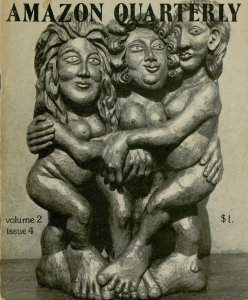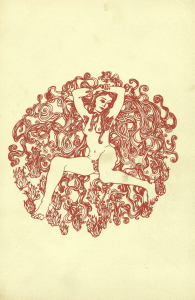
Front cover of Amazon Quarterly journal, vol. 2, no. 4, published in July 1974. In this issue, the feminist periodical is addressing ageism towards older women. Pictured is a statue depicting three women embracing each other while nude.
As feminists became unsatisfied with how women were portrayed in the media, they resisted the normative beauty standards with art that celebrated more diverse kinds of women. The 1974 volume 2, number 4 issue of Amazon Quarterly centers around ageism and rights for older women. This once again resists another beauty standard––the appearance of youth. There is artwork depicting three older women warmly embracing each other while nude, providing a stark contrast to the body language and expressions on the faces of the stoic, young, and pampered women on the covers of Vogue Magazine. Additionally, each of the women pictured have different hair textures, face shapes, bone structures, and curvy body types. The race of each woman is also unspecified, meaning no skin color is being gloried over another. This resists the conventional beauty standards of small, defined features, white skin, thin bodies, and straight hair. Refreshing imagery of a woman comfortable in and proud of her nude body promotes a healthier standard by celebrating body types that are representative of more realistic, larger women. The women touching and embracing each other’s naked bodies also show resistance to the patriarchy and takes back power from men, since it is removing the pornographic connotation of nudity and turning it into a symbol of divine femininity.

Front cover of No More Fun and Games journal, published in October 1968. This journal deals with issues surrounding women’s liberation. Pictured is an abstract drawing of a nude, unshaven woman lying on a bed of plants.
The cover of the first issue of No More Fun and Games from the year 1968 similarly contains artwork representing a kind of woman who does not conform to conventional beauty standards. The woman is lying naked, revealing her unshaven self, even though the socially acceptable standard calls for her to shave her entire body for men. Conventionally, an unshaven woman is depicted as dirty, which has caused shame surrounding body hair. However, the plants in this image reinforce the idea that growing out body hair is natural. Having a feminist journal as a platform for self-expression allows her to very openly and vulnerably display her body as it is without the intention of advertising beauty standards or products. This emphasizes how important it is for women to not feel obligated to change how they are naturally for the purpose of being more appealing to men. The purpose of this kind of art in feminist media is to redefine beauty on the common woman’s terms in a way that makes no woman feel ugly or worthless the way they are.
Works Cited
Ellen O’Donnell, et al. “No More Fun and Games.” No More Fun and Games, no. 1, Cell 16, Oct. 1968, cover, https://jstor.org/stable/community.28041474.
Martha Courtot, et al. “Amazon Quarterly.” Amazon Quarterly, vol. 2, no. 4, Amazon Press, July 1974, cover pages, https://jstor.org/stable/community.28032327.
